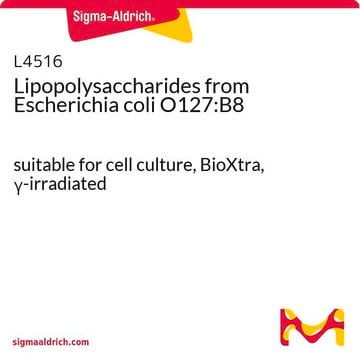Recommended Products
biological source
Escherichia coli
Quality Level
form
liquid
manufacturer/tradename
Chemicon®
shipped in
wet ice
General description
Lipopolysaccharide (LPS), also known as endotoxin, is present mainly in the cell wall of Gram-negative bacteria. It comprises three structural regions the O-side chain, a middle polysaccharide component, and Lipid A which contributes to the pyrogenic nature of LPS.
Application
LPS, E. Coli O111:B4 has been used for priming macrophages to upregulate genes necessary for NOD-, LRR- and pyrin domain-containing protein 3 (NLRP3) inflammasome activation. It has also been used to stimulate Raw264.7 cells before pull-down assay.
Biochem/physiol Actions
Lipopolysaccharide (LPS), an effective immunostimulant induces inflammatory and immune responses by activating Toll-Like Receptor 4 (TLR4). It also contributes to osteoclastogenesis in mice. LPS serves as a permeability barrier around the cell surface to restrict the entry of toxic molecules such as antibiotics and bile salts. It acts as a pyrogenic agent and eventually induces septic shock in host cells.
Quality
ANAYLISIS: <3% protein by Lowry assay.
Physical form
Liquid in PBS, pH 7.4.
Endotoxin Activity: Not less than 500,000 Endotoxin Units per mg of LPS as measured by the gel clot assay; chromogenic (Cambrex assays) toxicity assay measurements demonstrate approximately 10 EU/nanogram of LPS.
Endotoxin Activity: Not less than 500,000 Endotoxin Units per mg of LPS as measured by the gel clot assay; chromogenic (Cambrex assays) toxicity assay measurements demonstrate approximately 10 EU/nanogram of LPS.
Storage and Stability
Maintain at 2-8°C for up to 6 months in undiluted aliquots.
Good laboratory technique should be employed in the safe handeling of any lipopolysaccharide or lipid A product.
This requires observing the following practices:
1. Wear appropriate laboratory attire including a lab coat, gloves and safety glasses.
2. Do not mouth pipette, ingest or allow to come into contact with open wounds. Wash thoroughly any area of the body which comes into contact with the product.
3. This product is pyrogenic. Avoid accidental autoinjection by exercising extreme care when handling in conjunction with any injection device.
Good laboratory technique should be employed in the safe handeling of any lipopolysaccharide or lipid A product.
This requires observing the following practices:
1. Wear appropriate laboratory attire including a lab coat, gloves and safety glasses.
2. Do not mouth pipette, ingest or allow to come into contact with open wounds. Wash thoroughly any area of the body which comes into contact with the product.
3. This product is pyrogenic. Avoid accidental autoinjection by exercising extreme care when handling in conjunction with any injection device.
Legal Information
CHEMICON is a registered trademark of Merck KGaA, Darmstadt, Germany
Disclaimer
Unless otherwise stated in our catalog or other company documentation accompanying the product(s), our products are intended for research use only and are not to be used for any other purpose, which includes but is not limited to, unauthorized commercial uses, in vitro diagnostic uses, ex vivo or in vivo therapeutic uses or any type of consumption or application to humans or animals.
Storage Class Code
12 - Non Combustible Liquids
WGK
WGK 2
Flash Point(F)
Not applicable
Flash Point(C)
Not applicable
Certificates of Analysis (COA)
Search for Certificates of Analysis (COA) by entering the products Lot/Batch Number. Lot and Batch Numbers can be found on a product’s label following the words ‘Lot’ or ‘Batch’.
Already Own This Product?
Find documentation for the products that you have recently purchased in the Document Library.
Customers Also Viewed
The role of polyamines in the neutralization of bacteriophage deoxyribonucleic acid.
AMES, B N and DUBIN, D T
The Journal of Biological Chemistry, 235, 769-775 (1960)
Differentiation of in vitro-modified human peripheral blood monocytes into hepatocyte-like and pancreatic islet-like cells.
Maren Ruhnke,Hendrik Ungefroren,Andreas Nussler,Franz Martin,Marc Brulport et al.
Gastroenterology null
Nikolay N Kuzmich et al.
Vaccines, 5(4) (2017-10-05)
Toll-Like Receptor 4 (TLR4) signal pathway plays an important role in initiating the innate immune response and its activation by bacterial endotoxin is responsible for chronic and acute inflammatory disorders that are becoming more and more frequent in developed countries.
Lipopolysaccharide, structure, and biological effects
Schultz C
2006 IEEE Compound Semiconductor Integrated Circuit Symposium, 3 (2018)
Estimation of 3-deoxy sugars by means of the malonaldehyde-thiobarbituric acid reaction.
CYNKIN, M A and ASHWELL, G
Nature, 186, 155-156 (1960)
Our team of scientists has experience in all areas of research including Life Science, Material Science, Chemical Synthesis, Chromatography, Analytical and many others.
Contact Technical Service


